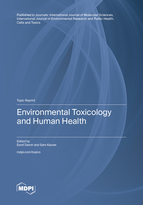Topic Menu
► Topic MenuTopic Editors

Environmental Toxicology and Human Health

A printed edition is available here.
Topic Information
Dear Colleagues,
Environmental contamination has now become a major global issue with adverse effects on our health and food security. Humans and animals are being exposed to debilitating levels of contamination on a daily basis. Across the globe, air pollution alone causes millions of premature deaths annually, mainly from lung cancer, chronic obstructive pulmonary disease, stroke, heart failure, and respiratory infections, and according to the World Health Organization (WHO), 99% of humanity breathes air containing contaminants above recommended levels. The United Nations has identified “a pollution-free planet” goal among its three pillars, in addition to climate change and biodiversity for 2022–2025. In order to mitigate contamination and relieve our burden of pollution-related disease, we need to devise target-specific strategies. To that end, risk assessment of each chemical and natural contaminants and solid evidence from toxicity studies appear to be of paramount importance. Meticulous efforts should be made to look into possible mechanisms of action for each pollutant and detect their toxic potential and safe limits through in vitro approaches and comprehensive in vivo animal testing. This Topic will focus on environmental pollutants (such as heavy metals, pesticides, nanoparticles, micro-nanoplastics, indoor air pollutants, pharmaceuticals, and industrial toxicants) and their human health effects, risk assessment, and relationship between various diseases and environmental pollutants. Human exposure to environmental pollutants may cause adverse effects such as neurotoxicity, carcinogenicity, infertility, and metabolic disorders. We welcome original research articles, reviews, and opinion pieces related to the proposed focus area.
Prof. Dr. Esref Demir
Prof. Dr. Sam Kacew
Topic Editors
Keywords
- environment and health
- risk assessment
- environmental pollutants
- cancer
- carcinogenesis
- toxicity
- biological effects
- molecular toxicology
Participating Journals
| Journal Name | Impact Factor | CiteScore | Launched Year | First Decision (median) | APC |
|---|---|---|---|---|---|

BioChem
|
- | - | 2021 | 54 Days | CHF 1000 |

Cancers
|
5.2 | 7.4 | 2009 | 17.9 Days | CHF 2900 |

Cells
|
6.0 | 9.0 | 2012 | 16.6 Days | CHF 2700 |

International Journal of Molecular Sciences
|
5.6 | 7.8 | 2000 | 16.3 Days | CHF 2900 |

International Journal of Environmental Research and Public Health
|
- | 5.4 | 2004 | 29.6 Days | CHF 2500 |

Biomolecules
|
5.5 | 8.3 | 2011 | 16.9 Days | CHF 2700 |

Environments
|
3.7 | 5.9 | 2014 | 23.7 Days | CHF 1800 |

Toxics
|
4.6 | 3.4 | 2013 | 14.7 Days | CHF 2600 |

MDPI Topics is cooperating with Preprints.org and has built a direct connection between MDPI journals and Preprints.org. Authors are encouraged to enjoy the benefits by posting a preprint at Preprints.org prior to publication:
- Immediately share your ideas ahead of publication and establish your research priority;
- Protect your idea from being stolen with this time-stamped preprint article;
- Enhance the exposure and impact of your research;
- Receive feedback from your peers in advance;
- Have it indexed in Web of Science (Preprint Citation Index), Google Scholar, Crossref, SHARE, PrePubMed, Scilit and Europe PMC.


